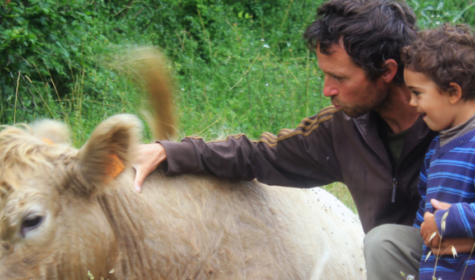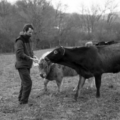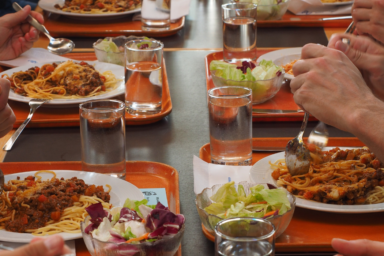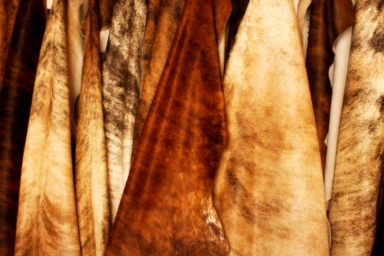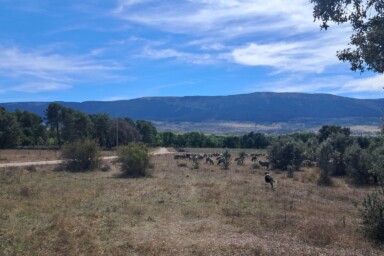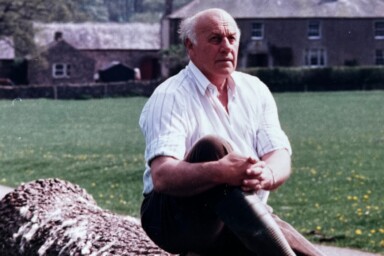It was the middle of October 2015, on a warm and sunny autumnal afternoon, when I got the news. My younger brother had committed suicide. He was supposed to be visiting us on the farm later that week, but it just wasn’t meant to be.
Five weeks later, returning from the family home in Worcestershire, I went straight to the wooded hillside where our cows, the Galloways and Castas, had been in our absence.
Perhaps it was the events of the preceding weeks that stirred the emotions, who knows, yet on calling them, hearing them respond and eventually seeing their heads poking out of the woodland’s edge, tears came to my eyes and for a moment, all the grief just slipped away.
Over the coming weeks, as autumn rolled into winter and the twice-daily round of feeding the cows began, I found myself becoming ever more grateful just to be in the presence of the six heifers we had at the time.
The Galloways were short, stocky and snug in their winter coats; the Castas, sleek, agile and already in possession of a fine set of black-tipped horns. Without a tractor and set of forks to lift the round bales of our own hay into the feeder, the contact with them during feeding time was always [and continues to be] up close and intimate.
The passing of my brother seemed to have effected a change in me, in the way things were seen and it appeared, with the cows in particular, that their characters, their habits and funny little ways were suddenly visible in a way not previously perceived.
Right from the start, we had an unshakable commitment to raising them in as natural a way as possible. When we bought the farm, it had been certified organic for 25 years.
There was a history of respect, grounded in pesticide-free compassion-based farming, that was in the soil and I’m sure that as we began to put down roots of our own, both us and the cows simply connected with something wholesome and alive that was already there.
As the months went on, I found myself spending as much time with the cows as possible, whether it was feeding them, fixing fences around them or freeing-up more grazing by clearing away stands of bramble and thick scrub.
At the time, I felt some kind of magnetism, pulling me ever onwards in their direction, and it came to me one day that the grieving for my brother stopped whenever I was in their company. They were helping me heal without any effort at all, simply by being.
Within six months, I felt little or no pain in relation to the loss. There was only acceptance and the hole in the stomach that had sometimes felt like a bottom-less pit was filled with the warmth of gratitude – for having known my brother and for just how effortlessly the cows had helped me to heal.
The cows have led us deeper and deeper into their ways. There are currently seven Galloways and ten Castas. The two breeds are separated, and each has a fine young bull to keep the heifers and cows company.
The Galloway heifers have become wonderful mothers and only recently, we saw the birth of our first beautiful little Casta calf. This is a particularly joyous occasion, as the Casta breed remains critically endangered.
This once iconic and most populous breed of the central French Pyrenees is down to a population of around 350 breeding cows.
Our commitment to the most natural form of livestock farming has only intensified and it is without doubt a result of knowing each calf, heifer, cow and bull as a living, breathing being worthy of our deepest respect, attention and care.
Reading the reissued edition of Rosamund Young’s absolute gem of a book The Secret Life of Cows, has only served to reinforce the sense that everything that is happening here is naturally, the right way to go about the rearing of livestock. What a wonderful way to receive such a confirmation!
It is then almost with a sense of reverence that I go to the cows each morning, to see how they are doing and perhaps to listen to what they can tell me of the day to come.
It is they who reflect back the wisdom of natural care, their shining coats and eyes which speak of a diet of grasses and herbs, of abundant wildflowers and acorns in autumn. I’ve even seen the Castas eating mushrooms when the season is on us.
Both herds overwinter outside, in meadows and woodland that are sacrificed for the purpose. The hay they are fed is sourced as locally as possible, and always comes from organic, flower-rich meadows. It is the only supplementary feed they get during the year. They are antibiotic, disease-free cattle, living in as close a way as possible to the life that their wild ancestors might have lived before domestication. It is their innate intelligence that informs me, what is best for them. In an atmosphere of mutual trust, where learning to listen to the language they speak is of the upmost importance, they themselves will indicate all that needs to be done.
Being sensitive to this, has granted us access to what feels like the inner workings of the herd and from this position there comes ever more enthusiasm to provide the very best conditions possible for their health and wellbeing. It is a way of saying thank you to them for how much they enrich our lives.
Recently, we have begun to treat the cows homeopathically. For example, two of the Galloway calves had developed quite severe warts on their heads and necks. A single treatment of ten granules of Thuja 10c for each calf, in combination with a vigorous dosing and rubbing of each wart with organic cider vinegar had them both wart free within a week. The cider vinegar has also proved to be incredibly successful in treating external maladies such as ringworm.
In emergency situations, such as a potentially fatal tick infestation in spring or a damper than usual autumn, the vet will be called and their advice taken, if it means saving a life. Yet less and less is this course of action necessary.
Farming in a way that specifically encourages vibrantly healthy ecosystems in the form of diversity-rich meadows, woodland and streams really does seem to inherently reduce the cows’ susceptibility to disease and illness.
As much as it is a farm, we like to see the land we look after as a sanctuary for all forms of wildlife. Land management work, involving brush-cutters and chainsaws, only happens in winter when amphibians, birds, insects and reptiles are less active. Large stands of blackthorn, bramble, hawthorn and gorse are left untouched to provide as much habitat as possible for wild boar, roe deer, fox, pine martin, a host of nesting birds and the elusive genet.
It may seem too simplistic, too child-like and naïve in an age of almost forensically intense analysis, but happy land really does mean happy cows and happy cows can mean happy farmers who may want to share something about the joys of their happy discoveries.
This spring, we welcomed our first guests to the farm, to participate in a retreat, simply entitled Being with Cows. The retreats, which are held once a month from April through October, are another way of saying thank you to the cows, to the land and to the wildlife that so enrich our lives here on the farm.
After the death of my brother, reflecting on how the cows helped me to heal, I began to wonder if they could touch others in the same way? It was out of this, that the idea for the retreats came and slowly took hold. I simply wanted to share the rich seam of gold, I felt I had discovered. Perhaps they could prevent another suicide, perhaps they could soothe a troubled mind and stop, if but for a moment, the spinning of an increasingly frantic world?
If you are interested in finding out more about the retreat ‘Being with Cows’ visit the farm’s Facebook page here.
